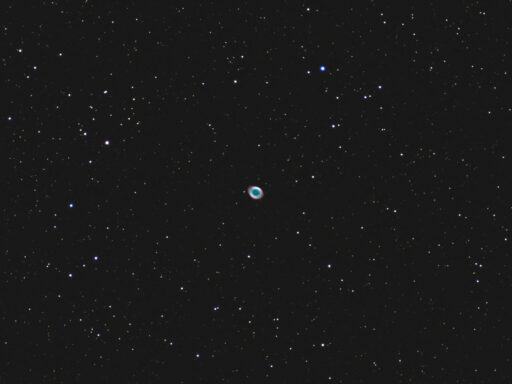
Telescope: Unitron 510 5” f/16 refractor, Atlas EQ-G
Camera: Canon EOS Ra full frame DSLR
Filter: 2” Baader Fringe Killer (Minus Violet)
Guide scope: Williams Optics 50mm Guidescope, ASI290MM, PHD
Exposure: 18x120sec, ISO 1600, saved as RAW
Darks: Internal (Long Exposure Noise Reduction)
Flats: 32×1/125s tee shirt flats taken at dusk
Average Light Pollution: Bortle 8, very poor transparency, haze, smoke, full moon
Lensed Sky Quality Meter: 17.8 mag/arc-sec^2
Stacking: Mean with a 1-sigma clip
White Balance: Nebulosity Automatic
Software: Backyard EOS, Deepsky Stacker, Nebulosity, Photoshop
Visually, the Ring Nebula appears as a ghostly smoke ring about the size of Jupiter. The nebula itself is not actually a ring, but more likely a torus or a short hour-glass, we just happen to the looking down the long axis, giving the nebula its characteristic shape.
This is the second of two images taken to evaluate the performance of Unitron 510 for imaging and the Baader Fringe Killer Filter. There is still just a tad of violet fringing around some of the brighter stars, but it is much reduced as compared to an image of the same field taken without the filter. This field is a 100% crop of the center of the original frame showing a nice amount of detail in the structure of the nebula.
M57 is currently well placed high overhead the east in the early evening. (Photo credit: John Graham, 7-30-2023)
Recent Comments